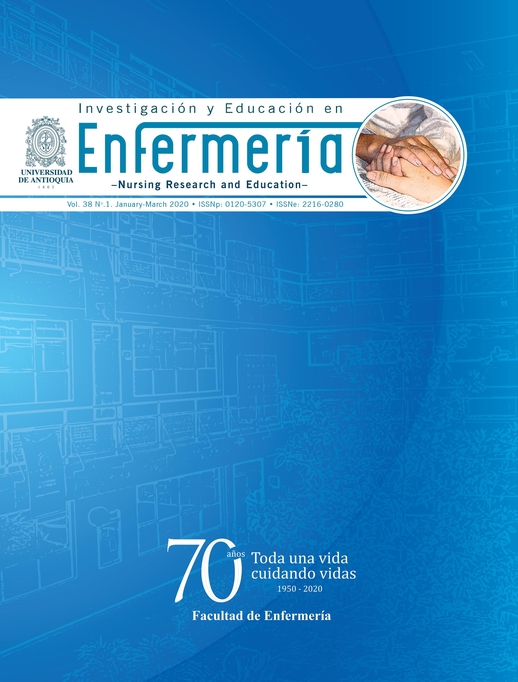Nursing Student Experiences of Caring for Burned Patient: From Fearfulness to Normalization
DOI:
https://doi.org/10.17533/udea.iee.v38n1e09Keywords:
Qualitative research, attitude, students, nursing, nursing care, burn units, education, nursing.Abstract
Objective. To describe the care experiences of students in burn units.
Methods. Qualitative research of the phenomenological descriptive type which was conducted with the participation of eight senior nursing students in Shiraz College of Nursing and Midwifery, Iran. The method used for gathering data about Student experiences in Care Services for Burn Cases was the individual semi-structured interview. The Colaizzi method was used for analysing and interpreting the data.
Results. Three main themes emerged: the attractive but stressful experience, trying to adjust and metamorphosis in attitude. Taking care of burned patients led to metamorphosis and adaptation to the requirements of burn care due to the students’ improved attitudes, awareness and potentials. This finally turned the stressful nature of taking care of a burn patient into an attractive experience for them.
Conclusion. Students with little clinical experience of stressful working situations in burn units faced different challenges. Due to the specific nature of taking care of burned patients, the clinical experiences of nursing students who offer these services are unique.
How to cite this article:. Hosseini F, Momennasab M. Nursing Student Experiences of Caring for Burned Patient: From Fearfulness to Normalization. Invest. Educ. Enferm. 2020; 38(1):e09.
Downloads
References
(1) Salmond SW, Echevarria M. Healthcare Transformation and Changing Roles for Nursing. Orthope. Nurs. 2017; 36(1):12-25.
(2) Bayuo J. Nurses’ experiences of caring for severely burned patients. Collegian. 2018; 25(1):27-32.
(3) Pascoe MC, Hetrick SE, Parker AG. The impact of stress on students in secondary school and higher education. Int. J. Adolesc. Youth. 2019:1-9.
(4) Gonçalves TSO, Moreira KFA, Albuquerque T. Assistência de enfermagem com pacientes queimados. Rev. Bras. Queimaduras. 2012; 11(1):31-7.
(5) Jamshidi N, Molazem Z, Sharif F, Torabizadeh C, Najafi Kalyani M. The Challenges of Nursing Students in the Clinical Learning Environment: A Qualitative Study. Sci. World J. 2016 [cited: 2020 Feb 5]. Available from: https://www.hindawi.com/journals/tswj/2016/1846178/
(6) Papastavrou E, Dimitriadou M, Tsangari H, Andreou C. Nursing students’ satisfaction of the clinical learning environment: a research study. BMC Nurs. 2016; 15(1):44.
(7) Tiwaken SU, Caranto LC, David JJT. The real world: Lived experiences of student nurses during clinical practice. Int. J. Nurs. Sci. 2015; 5(2):66-75.
(8) Holloway I, Galvin K. Qualitative Research in Nursing and Healthcare: Wiley; 2016.
(9) Yüksel P, Yıldırım S. Theoretical frameworks, methods, and procedures for conducting phenomenological studies in educational settings. Turk. Online J. Qual. Inq1. 2015 [cited: 2020 Feb 5]; 6(1). Available from: https://pdfs.semanticscholar.org/631a/a5935bc13fd667a2aaa6b8bdb97e03be1551.pdf?_ga=2.50618860.414999603.1581000257-1508944098.1559246799
(10) Guba EG, Lincoln YS. Competing paradigms in qualitative research. Handbook of qualitative research. Thousand Oaks, CA, US: Sage Publications, Inc; 1994. P. 105-17.
(11) Baraz S, Memarian R, Vanaki Z. Learning challenges of nursing students in clinical environments: A qualitative study in Iran. J. Educ. Health Promot. 2015; 4:52.
(12) Duncan JA. A qualitative study: The lived experience of burn unit nurses. United States: Capella University; 2016.
(13) Kornhaber RA. The lived experience of nursing severe burns injury patients: a phenomenological inquiry. Adelaide: The lived experience of nursing severe burns injury patients: a phenomenological inquiry; 2009 [cited: 2020 Feb 5]. Available from: https://digital.library.adelaide.edu.au/dspace/bitstream/2440/56331/8/02whole.pdf
(14) Cox C, Krout K, Navabi P, Markiewitz N, McColl M, Caffrey J. Prevalence of Burnout Syndrome in Burn Center Clinical Staff. J. Burn Care Res. 2018; 39:S9-S.
(15) Bradshaw C, Murphy Tighe S, Doody O. Midwifery students' experiences of their clinical internship: A qualitative descriptive study. Nurse Educ. Today. 2018; 68:213-7.
(16) McCarthy B, Trace A, O'Donovan M, O'Regan P, Brady-Nevin C, O'Shea M, et al. Coping with stressful events: A pre-post-test of a psycho-educational intervention for undergraduate nursing and midwifery students. Nurse Educ. Today. 2018; 61:273-80.
(17) Ahmed WAM, Mohammed BMA. Nursing students' stress and coping strategies during clinical training in KSA. J. Taibah Univ. Med. Sci. 2019; 14(2):116-22.
(18) Zhao FF, Lei XL, He W, Gu YH, Li DW. The study of perceived stress, coping strategy and self‐efficacy of Chinese undergraduate nursing students in clinical practice. Int. J. Nurs. P. 2015; 21(4):401-9.
(19) Kornhaber RA, Wilson A. Building resilience in burns nurses: a descriptive phenomenological inquiry. J. Burn Care Res. 2011; 32(4):481-8.
(20) Antoniolli L, Echevarría-Guanilo ME, Rosso LHd, Fuculo Junior PRB, Dal Pai D, Scapin S. Coping strategies of the nursing team acting in a burn treatment center.Rev. Gaúcha Enferm. 2018; 39: e2016-0073.
(21) Martins JT, Bobroff MCC, Ribeiro RP, Soares MH, Robazzi MLdCdC, Marziale MHP. Sentimentos vivenciados pela equipe de enfermagem de um centro de tratamento de queimados. Esc. Anna Nery. 2014; 18(3):522-6.
(22) Twigg D, McCullough K. Nurse retention: a review of strategies to create and enhance positive practice environments in clinical settings. Int. J. Nurs. Stud. 2014;51(1):85-92.
(23) Laschinger HKS, Fida R. New nurses’ burnout and workplace wellbeing: The influence of authentic leadership and psychological capital. Burnout Res. 2014;1(1):19-28.
Downloads
Published
How to Cite
Issue
Section
License
Copyright (c) 2020 Investigación y Educación en Enfermería

This work is licensed under a Creative Commons Attribution-NonCommercial-ShareAlike 4.0 International License.
Derechos de propiedad / Direitos de Propriedade
English: If the article is accepted for publication, all copyright will be of exclusive property of Investigación y Educación en Enfermería. The text and the graphics included in the publication are exclusive responsibility of the authors and not necessarily reflect the thought of the Editorial Committee.
Español: Si el artículo es aprobado para publicación, todos los derechos son de propiedad de Investigación y Educación en Enfermería. El texto y las gráficas incluidas en la publicación son de exclusiva responsabilidad de los autores y no necesariamente refleja el pensamiento del Comité Editorial.
Português: Se o artigo for aceito para publicação, todos os direitos autorais serão de propriedade exclusiva de Investigación y Educación en Enfermería. O texto e os gráficos incluídos na publicação são de responsabilidade exclusiva dos autores e não refletem necessariamente o pensamento do Comitê Editorial.















